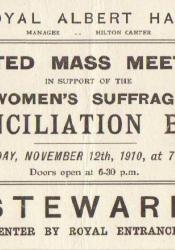Conciliation Bills
The Conciliation Bill was a bill that would give women who owned property as well as some married women the right to vote in England. If the bill had been passed it would have extended the right to vote to an estimated 1,000,00 women. The bill was brought up to the House of Commons on three separate occasions in 1910, 1911 and 1912. The bill gained a lot of support from women’s suffrage movements such as the Women’s Social and Political Union. The bill was rejected each year it was brought up to the House of Commons and in 1913 it was decided by constitutional suffragists that the bill would need to be rewritten completely to fit with the standards that the government was forcing on the bill for it to be passed. After it was decided that the bill would need to be completely rewritten the supporters of the Conciliation bills were left back where they started with no bill at all and no apparent hope for women to gain the right to vote. The bills were rejected in favor of the universal manhood suffrage bill. Many of the suffragettes and women’s suffrage supporters blamed the Prime Minister at the time H.H. Asquith for the rejection of the bills because he promised if re-elected he would give “facilities in the new Parliament for the passing of a Women’s Suffrage Bill.”
The articles related to the Conciliation bills are mainly news articles from the times the bill was proposed to the House of Commons. The journal article “The Women’s Suffrage Movement in England” shows the obstacles faced by suffragists and suffragettes while trying to get the bill passed as well as why the bill was not passed. In this article from pages 604-607, the conciliation bill is discussed from the conception of the bill to the bill’s eventual defeat. The article also discusses H.H. Asquith’s role in the bill as well as his promise to help the bill in parliament that he did not keep. The House of Commons favoring a universal manhood suffrage bill is also discussed in this article. The newspaper article Great Britain. There is again a Woman's Suffrage Bill before Parliament shows the actions taken by the suffragettes at the time as well as defining who the bill would give suffrage
Great Britain. There is again a Woman's Suffrage Bill before Parliament
Margaret
The English Conciliation Bill
https://timesmachine.nytimes.com/timesmachine/1911/03/02/104779920.pdf
Gardiner, Margaret Doane. “The English Conciliation Bill.” The New York Times, The New York Times, 2 Mar. 1911, www.nytimes.com/1911/03/02/archives/the-english-conciliation-bill.html.
Commons Refuse the Vote to Women
https://timesmachine.nytimes.com/timesmachine/1912/03/29/100357878.pdf
Marconi Transatlantic Wireless Telegraph to The New York Times. “COMMONS REFUSE THE VOTE TO WOMEN; Conciliation Bill Defeated by 222 to 208 Votes -- Ministers on Opposite Sides.” The New York Times, The New York Times, 29 Mar. 1912, www.nytimes.com/1912/03/29/archives/commons-refuse-the-vote-to-women-con...
The Women's Suffrage Movement in England
https://www.jstor.org/stable/pdf/1944309.pdf
Turner, Edward Raymond. “The Women's Suffrage Movement in England.” The American Political Science Review, vol. 7, no. 4, 1913, pp. 588–609. JSTOR, JSTOR, www.jstor.org/stable/1944309.

